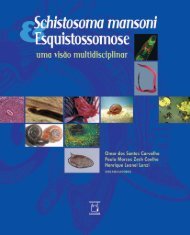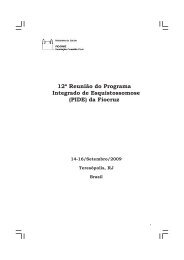English pdf, 1.64Mb - World Health Organization
English pdf, 1.64Mb - World Health Organization
English pdf, 1.64Mb - World Health Organization
Create successful ePaper yourself
Turn your PDF publications into a flip-book with our unique Google optimized e-Paper software.
Background and rationaleSchistosomiasisSchistosomiasis is the collective name for infection by one (or more) of five Schistosomaspecies (trematode worms) adapted to humans, i.e. S. mansoni, S. japonicum, S. haematobium,S. mekongi and S. intercalatum, or by species adapted to other mammals which canoccasionally infect humans, e.g. S. bovis and S. magrobowei. This complex helminth infectionrequires alternate development between an intermediate snail host and the final mammalianhost, both of which are indispensable for maintaining the parasite. In humans, the nature ofthe disease is largely immunological and only indirectly due to the parasitic worm itself; thepathological lesions emanate from inflammatory reactions to the large number of parasite eggswhich are retained in host tissues rather than excreted with the faeces or urine (to infect thesnail). The majority of schistosome species cause intestinal schistosomiasis, where the adultworm lives in the mesenteric venules of the host. However, the highest number of humaninfections is caused by S. haematobium, which has a predilection for the blood vessels aroundthe bladder and causes urinary disease.Spectrum of clinical pathologyMorbidity S. mansoni/S. japonicum S. haematobiumGeneral Acute schistosomiasis Acute schistosomiasisOrgan-specificpathologyDevelopmentalimpairmentAnaemiaHepatomegalySplenomegalyEctopic egg granulomasAlternative venous circulationGenital schistosomiasisCognitive dysfunctionDelayed growth/stuntingAnaemiaVesicular wall hardeningBladder cancerEctopic egg granulomasKidney malfunctionGenital schistosomiasisCognitive dysfunctionDelayed growth/stuntingUnderstanding the problem and initiating the correct avenues of research to deal with it arepivotal in improving the lot of people living in areas endemic for the major tropical diseases.There is strong evidence (from China, Brazil and Egypt) that morbidity due to schistosomiasiscan be controlled in areas where the necessary financial resources exist. However, eliminationas a public health threat has proved difficult. Schistosomiasis is reported to exist in 76countries in the Middle East, South America, South-East Asia, and particularly in Africa,where its long-term impact is staggering. Although the prevalence has hardly improved at allover the last few decades, the overall situation changed dramatically following introductionReport of the Scientific Working Group on Schistosomiasis, 2005 • TDR/SWG/07








